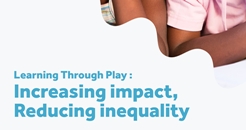 Play has the potential to reduce inequality
Play has the potential to reduce inequality
From an article by the Hechinger Report
What if one of the answers to reducing inequality and addressing mental health concerns among young children is as simple as providing more opportunities to play?
Play is so powerful, according to a report by the LEGO Foundation, that it can be used as a possible intervention to close achievement gaps between children ages 3 to 6. The report looked at 26 studies of play from 18 countries. It found that in disadvantaged communities, including those in Bangladesh, Rwanda and Ethiopia, children showed significantly greater learning gains in literacy, motor and social-emotional development when attending child care centres that used a mix of instruction and free and guided play. That’s compared to children in centres with fewer opportunities to play, especially in child-led activities, or that placed a greater emphasis on rote learning.
This is important, the report’s authors noted, as it shows free and guided play opportunities are possible even in settings where resources may be scarce. “Play can exist everywhere,” said Bo Stjerne Thomsen, chair of Learning Through Play at the LEGO Foundation. “It’s the experience. Testing and trying out new ideas…It’s really about the state of mind you’re in while playing.”
The report found that play enabled children to progress in several domains of learning, including language and literacy, social emotional skills and math. The varieties of play include games, open play where children can freely explore and use their imaginations and play where teachers provide materials and some parameters.
The findings suggest that rather than focusing primarily on academic outcomes and school readiness, play should be used as a strategy to “tackle inequality and improve the outcomes of children from different socio-economic groups.” That also means opportunities to play should be considered a marker of quality in early childhood programs, the authors concluded. Stjerne Thomsen said the authors have not defined an ideal amount of play as they believe it can be embedded throughout the day. More importantly, he added, is that teachers are trained to facilitate free play and guided play opportunities. “Play is often defined as recreation…not serious or practical,” said Stjerne Thomsen. Instead, many schools are focused on academic skills and standardized assessments, he added.
Experts say opportunities to play are essential for helping kids process their feelings and changes in their life, especially after the past year of disruption and trauma. “Play is absolutely an essential part of the healing process,” said Tena Sloan, a licensed therapist and the vice president of early childhood mental health consultation and training at Kidango, a nonprofit with a network of child care centres in California. “We need to give [kids] these other ways to diffuse their stress and express themselves.” That includes, she adds, “being outside and having that freedom to play.”
Read the full article here.
Retweet about this article:
From an article by the Hechinger Report, 18/08/2021